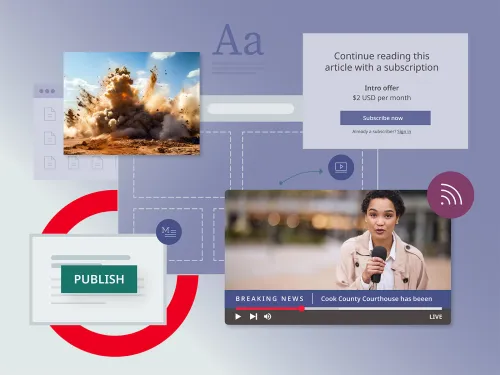CMS use cases
Brightspot’s enterprise-grade powerhouse of tools and templates offer the flexibility to craft front-end experiences, ensuring content delivery exactly as you need it.
Stay ahead of fast-paced news cycles with a digital-publishing platform that offers the tools that digital newsrooms need to report, edit, publish and collaborate at speed.
Connect with audiences worldwide in a more authentic way with content that captures the heart and soul of your company through storytelling.
Deliver impactful, brand-consistent digital experiences with a marketing-focused CMS built for scale. Empower your marketing team with tools to ensure faster time-to-market and improved marketing performance.
Manage your online library of information in a system that’s built to support varied and unique content types and specific permissions.
Empower your workforce with a modern intranet that’s fast, intuitive and personalized. Brightspot’s employee intranet solution boosts productivity, streamlines communication and makes everyday tasks easier.
Ensure brand consistency with a digital asset management system for all your digital assets, including reuse, version control, rights management and user access.
Featured CMS use case resources
ALM transitioned from a heavily customized WordPress CMS to Brightspot’s headless CMS, simplifying publishing and enhancing front-end flexibility.
Learn more about how customers are using Brightspot
Brightspot’s platform simplified the complex logistics of Drive, Chip & Putt, enabling real-time scoring and seamless event management. This allowed the program to deliver a consistent, top-tier experience across hundreds of events, inspiring young golfers nationwide.
Discover how the American Institute of Physics transformed its content strategy with Brightspot’s CMS, in partnership with solutions partner ModOp, enhancing efficiency and ensuring future success.
Lexipol faced the challenge of modernizing a legacy CMS while supporting five brands and managing two decades of content. With Brightspot’s robust content platform at the heart of its new approach, Lexipol transformed its digital presence, streamlining workflows and enhancing content delivery across all platforms.
Starting in 2021, Midwestern media publisher Forum Communications set out to transform the digital experience for both readers and newsrooms across its portfolio of 20-plus newspaper and media brands.
Discover how Editorial Televisa, a powerhouse in Mexican media, achieved digital transformation with Brightspot CMS, streamlining operations and propelling growth. From rapid migration off WordPress to enhanced customization, see how Brightspot empowered Editorial Televisa to deliver top-notch content to diverse audiences across their iconic brands.
Brightspot helped the American Junior Golf Association (AJGA) replace its legacy platform with a powerful new CMS able to support live events, tournament scorecards, player leaderboards and membership management with an integration to Salesforce.
Discover how Brightspot empowered Grupo AJ Vierci’s digital revolution, enhancing the digital presence for several publications in its family of brands with seamless content migration, sophisticated publishing tools and integrations for a modern multimedia experience.
Discover how TV Azteca transformed its digital presence with Brightspot CMS, gaining greater enhanced efficiency, agility and cost savings across dozens of sites across its media portfolio.
Enterprise CMS resources
If your company has a global presence, offers multiple products or services, and reports annual multimillion-dollar revenues, you need a content management system that’s capable of handling that volume and reach. An enterprise CMS provides a centralized solution for all your departments and locations, empowering your organization to execute a successful enterprise content management strategy.
Learn the key CMS features large enterprises need for scalability, security and flexibility to deliver content across multiple channels efficiently.
A growing business needs a CMS that keeps pace with its ambitions. An enterprise headless CMS offers the scalability, security and seamless integrations needed to power content across every channel — ensuring efficiency, flexibility and future-proof digital success.



















